Best AI Agents in 2025: Top 15 Tools, Platforms & Frameworks

Skip ahead
Best AI Agents in 2025: Top 15 Tools, Platforms & Frameworks
If you’re a developer building smarter tools, a professional buried in admin, or a business owner juggling multiple workflows, the work never stops.
Without an AI agent, you’re likely bouncing between spreadsheets for reporting, inboxes for follow-ups, calendars for scheduling, and dashboards for project tracking.
A recent report shows 85% of enterprises plan to adopt AI agents by the end of 2025, as leaders see them as a way to cut through this inefficiency.
In this article, I’ve rounded up the 15 best AI agent platforms in 2025. You’ll see what each one does, its pros and cons, and who it’s best for.
What is an AI Agent?
An AI agent is a software system that uses artificial intelligence to pursue goals and complete tasks on behalf of users. Unlike a simple AI assistant that mainly responds to prompts, an agent can reason, plan, remember context, and act with some level of autonomy.
Modern AI agents are powered by foundation models and generative AI, which give them multimodal abilities. They can process text, voice, images, video, code, and more at the same time. This allows them to converse, analyze, and make decisions while learning and improving over time.
Agents also work together in teams, coordinating with other agents to handle more complex workflows, automate business processes, and manage transactions without constant human oversight.
What to Look for in an AI Agent Platform?
To pick the right platform in 2025, here are the things to evaluate:
- Autonomy in planning and decisions.
- Memory and context handling.
- Integrations with external tools.
- Scalability and reliability.
- Ease of use and flexibility.
- Safety, privacy, and ethics.
Our Picks – 15 Best AI Agents in 2025
Here’s a look at the 15 best AI agents for 2025, how they work, what they’re good at, where they struggle, and the use cases they fit best.
1. Sintra AI
Best for: Entrepreneurs, small business owners, and teams that need an AI workforce rather than just a single assistant
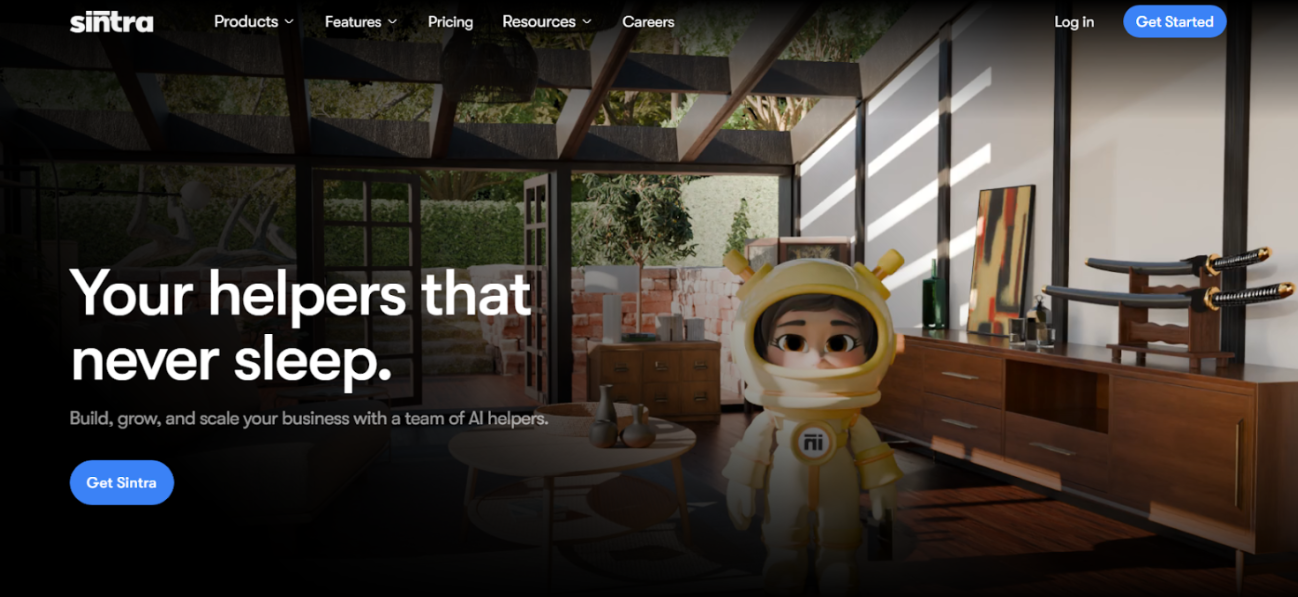
Sintra AI offers a team of specialized AI agents (they call them “helpers”), each assigned to business functions like marketing, customer support, sales, e-commerce, recruiting, and data analysis.
These agents work under a central “Brain AI” that maintains brand context, files, tone, and preferences. Sintra’s platform moves beyond simple prompt-and-response by providing agents that can anticipate tasks, suggest improvements, and automate complex tasks and routine tasks.
Core Features
- Specialized Helpers: 12 distinct agents (e.g., Social Media, Copywriting, Customer Support), each trained for specific roles.
- Brain AI: A knowledge hub that stores documents, guidelines, and files so that agents maintain consistency and context when generating responses or performing tasks.
- Power-Ups and Automations: Over 90 “Power-Ups” (micro-tools) to extend capability without extra tool-hopping.
- Global Context Agent: A feature that lets you recall past conversations across agents, so agents can act with awareness of earlier discussions and avoid repetition.
- Multilingual, 24/7 Availability: The helpers support 100+ languages, ready to work any time, which helps with tasks like support tickets, international outreach, or content in multiple locales.
Strengths
- Reduces the need for technical expertise or managing multiple separate AI tools
- Agents stay on brand and remember business details through Brain AI
- Proactive suggestions for content, marketing, or strategy.
Weakness
- With many Power-Ups and agents, there’s a learning curve: knowing which helper to assign to what task takes a little experience.
Sintra Pricing
Sintra AI offers several pricing tiers. The base plan for accessing some helpers and core features starts at a lower rate, while the full “Sintra X” plan (all helpers, full set of Power-Ups, Brain AI, etc.) goes higher. There’s also a 14-day money-back guarantee.
User Reviews
Review #1: “What I like best out of this tool is that you can rework something without making it “worse”. This way you can tailor an output based on a specific structure you have in mind.”
Review #2: “We've been using Sintra.ai as a recent small business. We really like the concept, and so far it's been proven very useful, and saving us a lot of time. It helps being organized and feels like having a time.”
2. AutoGPT
Best for: Developers and technical users who want to build custom AI agents for complex tasks

AutoGPT is one of the most popular open-source AI agent platforms. It’s designed around the idea of autonomous AI agents that can plan and perform tasks with minimal human input.
Built on large language models, AutoGPT can chain prompts, make API calls, and interact with external tools to complete multi-step workflows. While it requires some technical expertise, it remains a go-to choice for developers experimenting with the future of AI.
Strengths
- Plan and execute multi-step processes without constant human guidance.
- Let's developers design and run custom AI agents.
- Capable of connecting with APIs, plugins, and third-party apps.
- Handles complex tasks like research, automation, and even writing code.
- Adaptable for various domains and tech stacks.
Weakness
- Requires significant technical expertise
- Can be unstable in some cloud environments
- Setup takes time compared to plug-and-play AI apps
AutoGPT Pricing
AutoGPT is free to use as an open-source AI tool, though costs may apply for API usage (e.g., OpenAI or other LLM providers).
3. LangChain
Best for: Developers who want to build custom AI agents and workflows with large language models
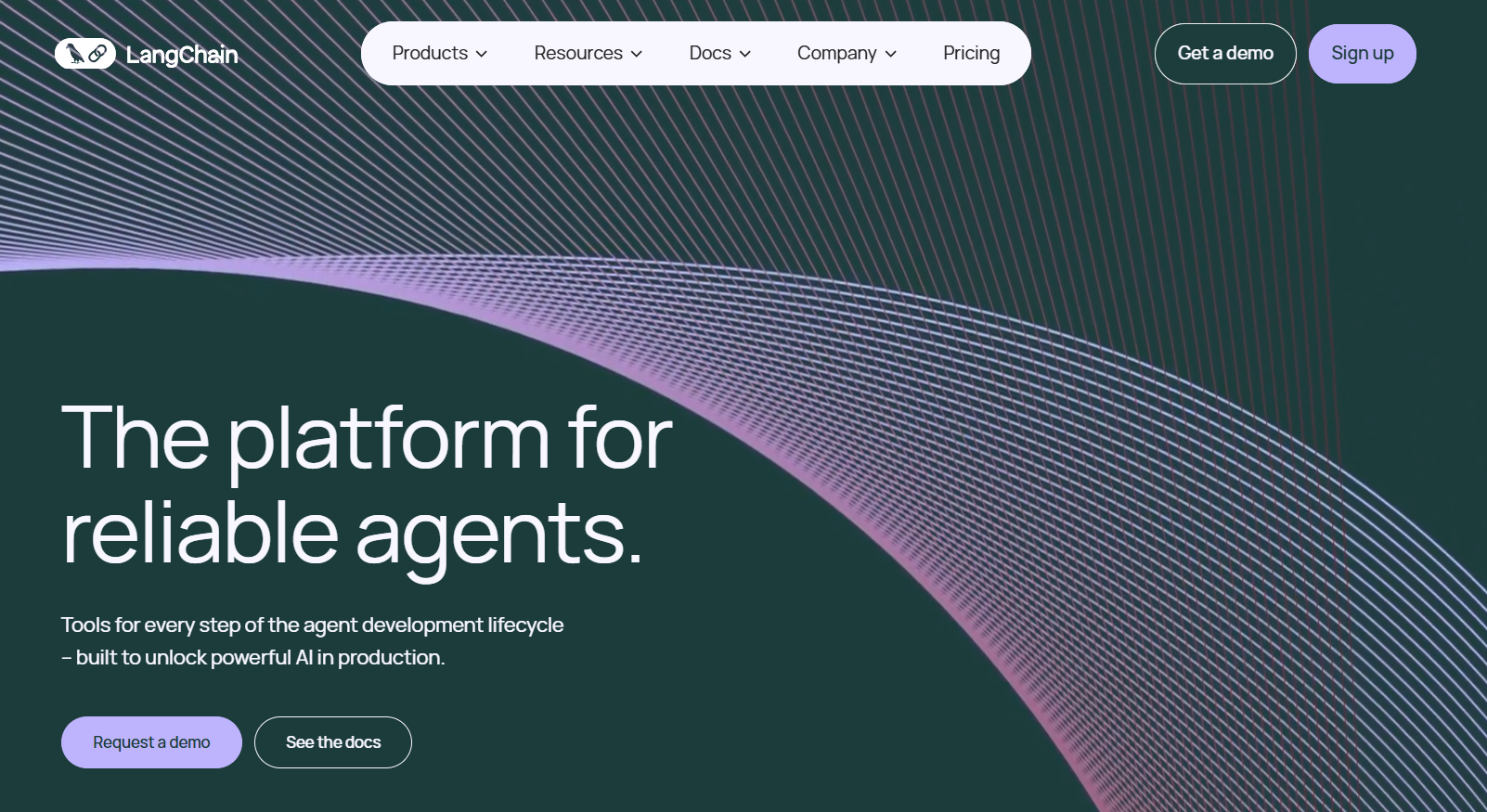
LangChain is a leading AI agent platform and open-source framework that allows teams to build, deploy, and manage autonomous AI agents using large language models.
It supports a modular architecture where you combine Chains, Agents, Memory, and Tools to enable agents that can reason, call external tools, maintain context, process data, and perform tasks that go beyond single-turn interactions.
LangChain’s LangGraph Platform lets teams run agent workflows at scale, with tools to track, debug, and manage them in production.
Strengths
- Agent builder framework for custom AI agents
- Prompt engineering, memory, and prompt chaining support
- Works with multiple LLM providers like OpenAI and Anthropic’s Claude
- Integrations with databases, vector stores, and APIs
- LangGraph for workflow automations and multi-agent orchestration
Weakness
- Requires technical expertise and coding knowledge
- Steep learning curve for setup and maintenance
- Scaling and error handling in production can be complex
LangChain Pricing
LangChain is open source and free. Paid add-ons like LangSmith and LangGraph Platform offer monitoring, observability, and enterprise-grade deployment.
4. CrewAI
Best for: Teams and developers who want multiple agents working together on complex workflows
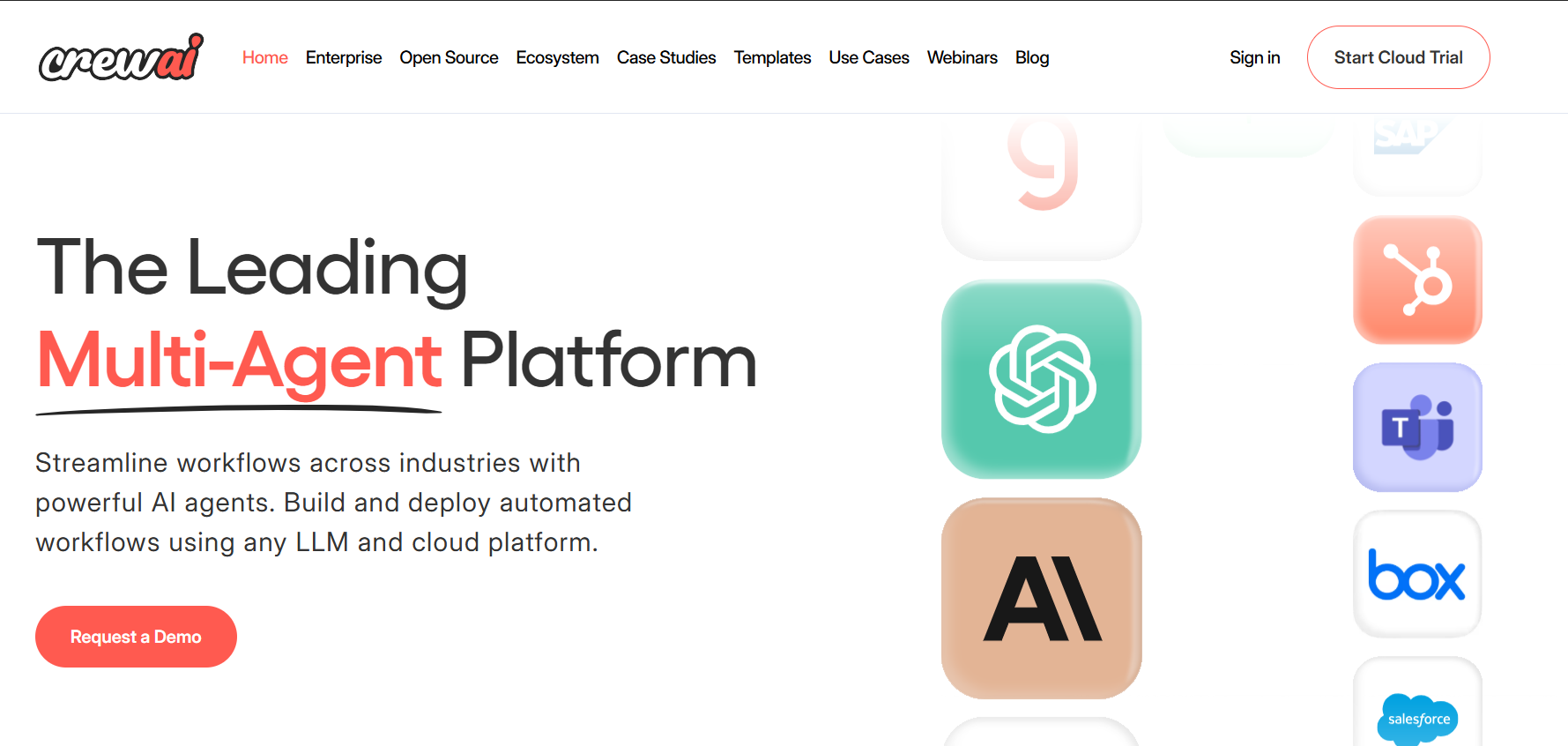
CrewAI is an AI agent platform built for collaboration. Instead of one agent handling everything, you can create “crews” of role-based agents that split tasks and work together. It connects with large language models, external tools, and APIs so agents can perform tasks, process data, and complete projects in parallel.
Strengths
- Role-based agents that specialize in different parts of a workflow (e.g., data processing, customer service, decision making)
- Multiple crews (groups of collaborating agents) with real-time monitoring and observability
- Flexible use of LLM providers and models; you can use open-source models or ones from providers like OpenAI or others
- A mix of no-code/low-code tools and code frameworks to set up, test, debug, and deploy workflows and agents
Weakness
- Needs technical expertise to design and manage crews
- Usage costs rise quickly with heavy workloads
- Takes time to optimize agents so they don’t overlap or waste resources
CrewAI Pricing
CrewAI has a free, open-source core. Managed cloud plans start around $99/month, with higher tiers offering more active agents, monitoring, and premium support.
5. Cognosys (now Ottogrid)
Best for: Research and operations teams that want an AI agent to automate data gathering, email workflows, and scheduled tasks
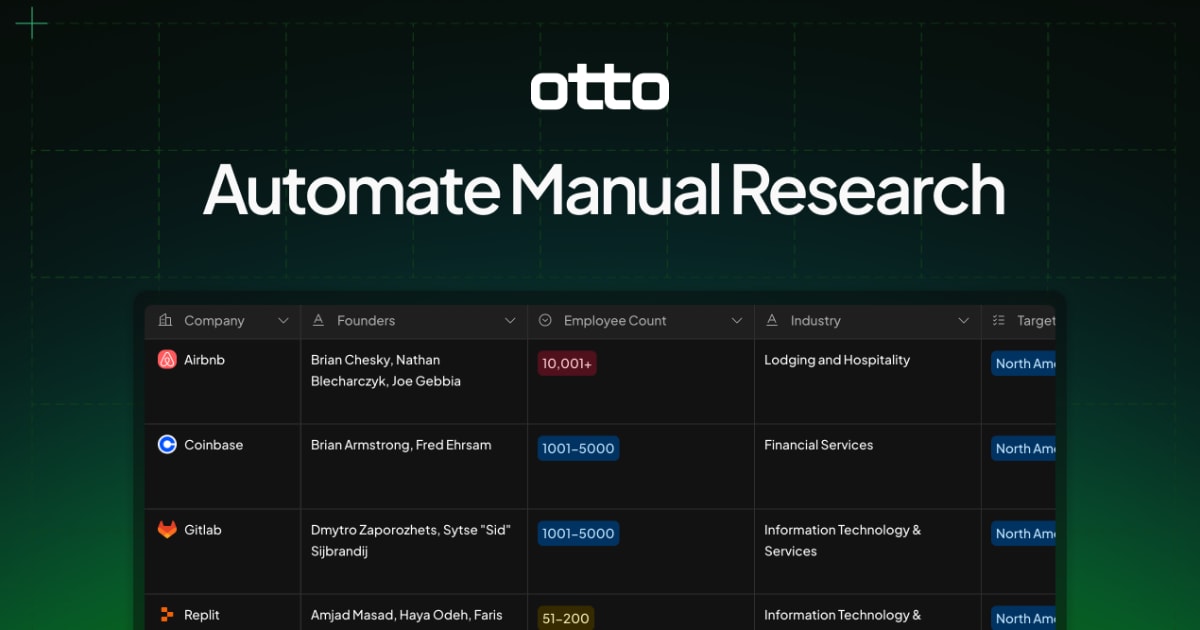
Cognosys lets you hand off objectives in natural language, then an autonomous AI agent breaks them into steps, runs searches, and executes workflows (email summaries, reports, scheduling).
The product is being deprecated and transitioned to Ottogrid; in May 2025, Ottogrid was acquired by Cohere. If you’re evaluating Cognosys today, look at Ottogrid/Cohere for the current path.
Strengths
- One-time, scheduled, and event-triggered flows (e.g., label new emails, send daily briefs).
- Gmail, Google Calendar/Drive, Notion, Outlook; agents can call external tools and make API calls inside flows.
- “Give objectives, not questions.” The agent plans complex tasks, does web research, and handles data processing/data analysis before drafting outputs.
- Reduces tool-hopping; acts as a central hub for email, docs, and research.
- Fits AI workflows like reports, newsletters, and inbox triage.
Weakness
- Platform is in transition (Cognosys → Ottogrid → now under Cohere), so features and pricing may change
- Advanced, high-volume automations can require paid tiers.
Cognosys Pricing
Historically offered a free plan with paid upgrades; current tiers live under Ottogrid/Cohere and may differ. Check Ottogrid/Cohere for up-to-date pricing.
6. AgentGPT
Best for: Users and small teams who want to create and run autonomous AI agents directly in the browser
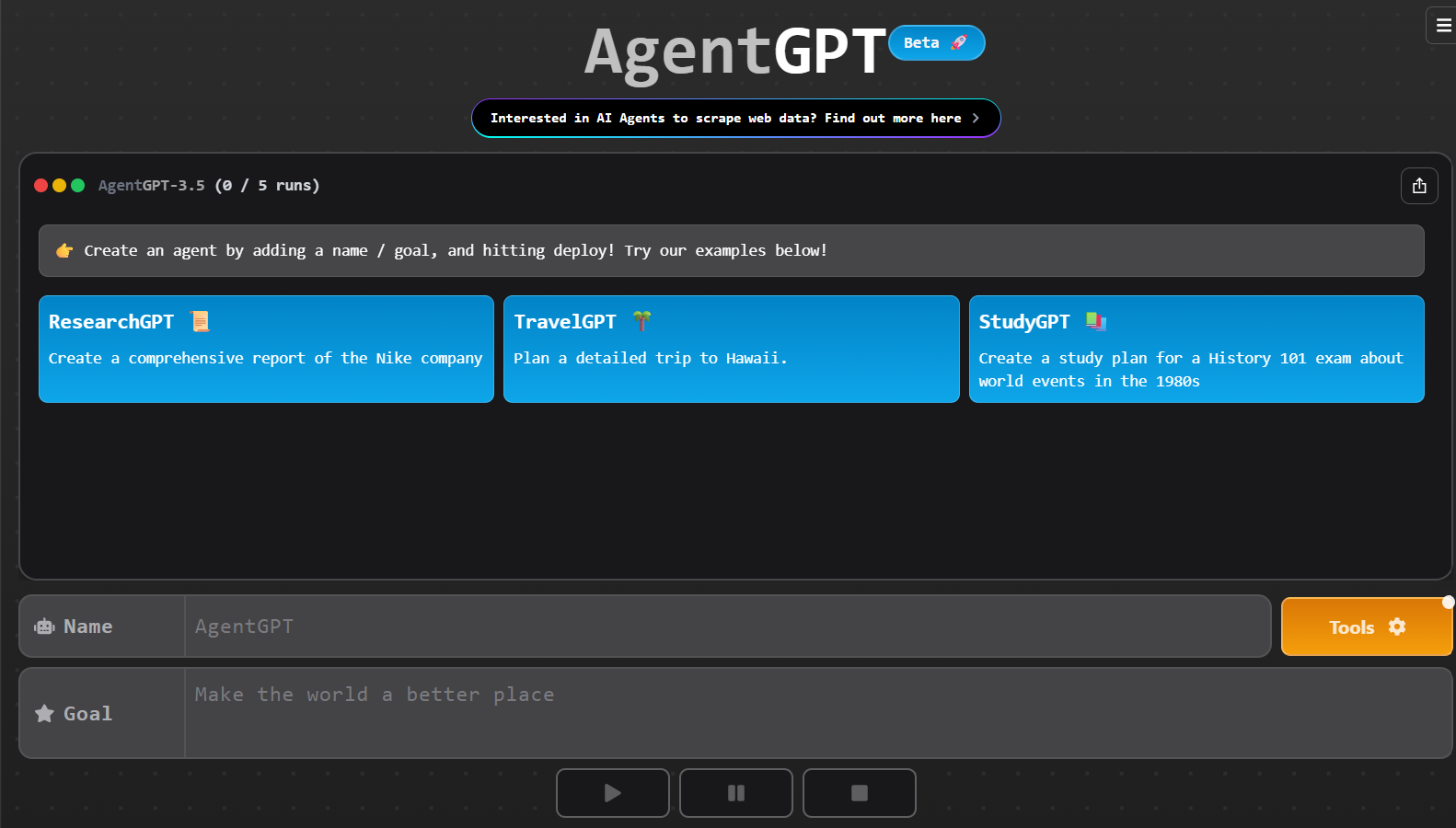
AgentGPT lets you type a goal in natural language, and then it creates an agent that plans, breaks it into steps, and acts to complete it.
It is one of the more accessible AI agent platforms, giving users a way to test custom AI agents without advanced coding skills. The agents can handle complex tasks like research, writing, and light automations.
Strengths
- Browser-based agent builder with no installation required
- Goal-driven planning and step-by-step execution
- Templates for common tasks like research, content generation, and planning
- Support for connecting agents with APIs and external tools
- Useful for testing AI workflows quickly without technical setup
- Allows non-developers to try custom AI agents
- Good for experiments and small projects
Weakness
- Limited scalability compared to frameworks like LangChain or CrewAI
- Agents may need manual correction when handling complex tasks
- Advanced features require moving to paid tiers
AgentGPT Pricing
AgentGPT offers a free plan with limited agents and basic search. The Pro plan, around forty dollars per month, adds GPT-4 access, more agents, larger context windows, and plugin support. Enterprise plans include custom limits and premium features.
7. Adept ACT-1
Best for: Professionals who want an AI agent that can use software and complete tasks through natural language commands

Adept’s ACT-1 (Action Transformer) is one of the first AI agents built specifically for tool use. Instead of just generating text, ACT-1 can look at a user interface, understand it, and carry out actions like a human would.
This makes it stand out among AI agent platforms, since it focuses on learning how to use apps and systems directly rather than requiring heavy integrations.
Strengths
- Executes tasks by interacting with existing software interfaces
- Trained on actions, not just language, for better tool usage
- Supports complex tasks like booking meetings, updating CRMs, and managing workflow automations
- Uses large language models combined with reinforcement learning
- Works in natural language, no need for prompt engineering skills
- Reduces manual busywork by acting as an AI teammate
Weakness
- Still limited in availability compared to open-source agent platforms
- Requires trust with sensitive business data
- Can be slower with unfamiliar interfaces or new agent actions
Adept ACT-1 Pricing
Adept ACT-1 is not generally available as open source. Pricing and access are offered through Adept’s enterprise partnerships and pilots.
8. Meta’s LLaMA Agents
Best for: Developers and organizations interested in open-source AI agents that they can run and customize themselves
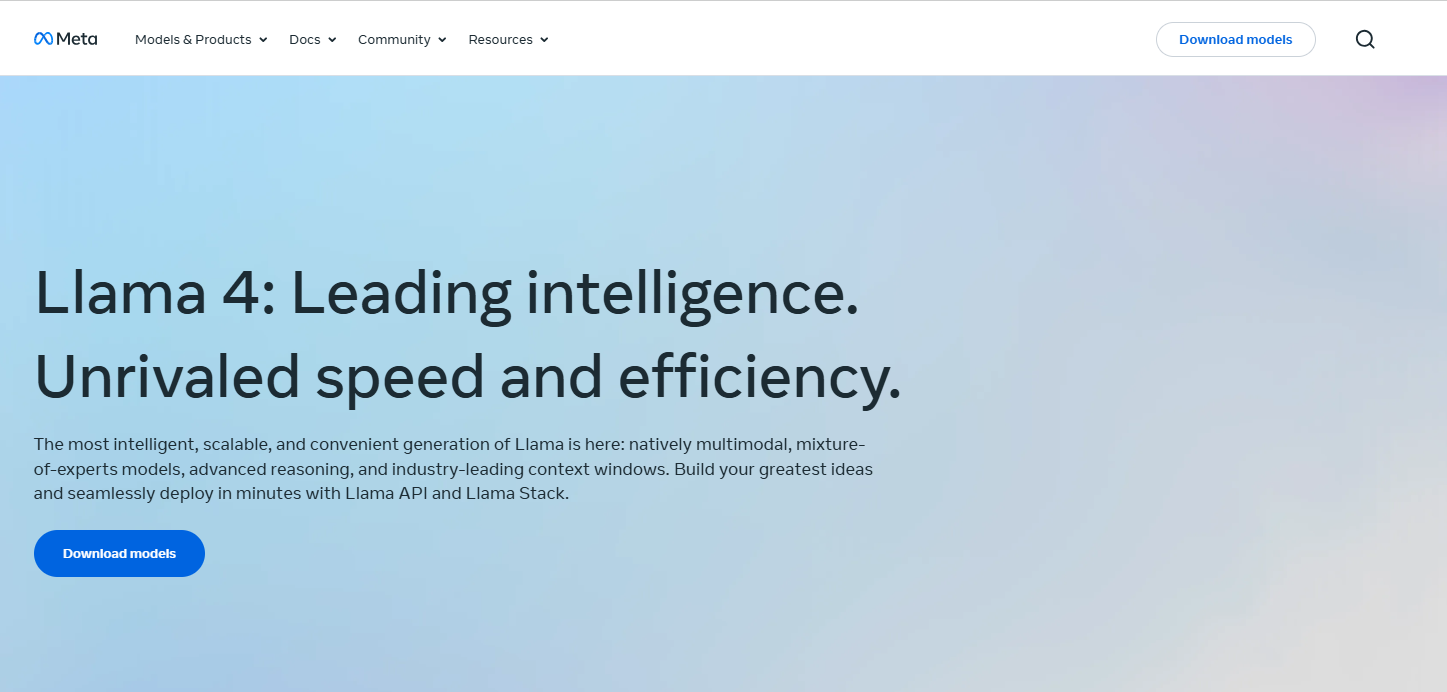
Meta’s LLaMA (Large Language Model Meta AI) provides open-source LLMs that many are using as a base for building custom AI agents.
Because LLaMA models are publicly available, teams can fine-tune them, add memory, plug in APIs, and build agents that perform tasks in various domains. Using LLaMA agents means you control deployment, model tweaking, and data flow.
Strengths
- Models are open source, so you can adjust them for your needs (fine-tuning, custom prompt templates).
- You can integrate with external tools, APIs, and databases to build agents that fetch or process data.
- Supports “agent builder” style setups: people are using LLaMA in frameworks like LangChain or custom stacks to build agents that do complex tasks, maintain memory, or work in chains.
- Easier to experiment with local deployment or private cloud, which helps with privacy and control.
Weakness
- Requires technical expertise to set up fine-tuning, memory systems, and tool integrations
- You will need to build more of the surrounding system yourself (error handling, agent orchestration, observability)
- No out-of-the-box polished UX or dashboards like commercial agent platforms
LLaMA Pricing
Because LLaMA models are open source, you don’t pay for the model itself. Costs come from infrastructure (servers, storage, API hosting), fine-tuning, and the tools you build around them.
9. DeepSeek
Best for: Developers and teams who want a cost-effective, high-performing platform to build AI agents and language model tools

DeepSeek is an AI platform built around powerful large language models like DeepSeek-V3 and DeepSeek-R1. It supports tasks such as reasoning, code generation, and natural language processing.
Users can use DeepSeek to build custom AI agents or integrate its models via API to automate workflows, analyze data, or generate content. It aims to balance performance and affordability, making advanced AI capabilities more accessible.
Strengths
- Models optimized for reasoning, coding, and multimodal input (text + other modalities)
- API access for building autonomous agents or embedding language-model capabilities in apps
- Good support for natural language processing, prompt engineering, and chaining tasks
- Lower cost per token compared with some major Western alternatives; freemium or pay-as-you-go pricing helps with smaller scale or startup usage
- Works for prototyping or integrating into production workflows
Weakness
- Some concerns around privacy, data jurisdiction, and stability in certain geographies due to server location and regulatory issues
- Documentation and tooling still catch up compared to more mature agent platforms
- Performance and latency vary based on usage levels or API load
DeepSeek Pricing
DeepSeek offers a free access option for basic usage. Paid plans vary depending on model (like V3 or R1), token usage, and API calls.
10. Devin AI
Best for: Software development teams and professionals who want an AI partner that can handle end-to-end coding workflows
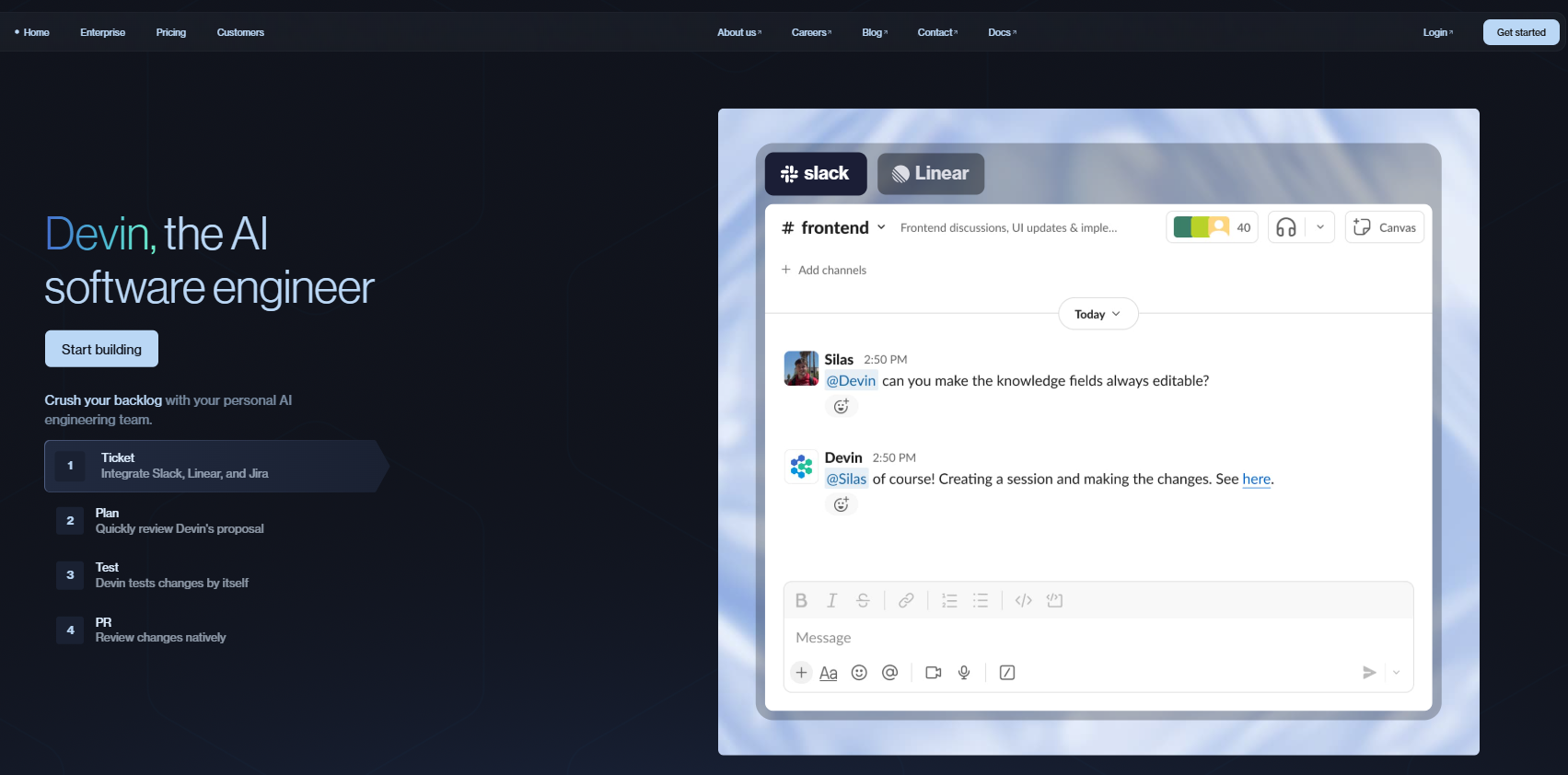
Devin AI is widely recognized as the world’s first AI “software engineer.” Unlike typical coding assistants, Devin can plan, write, debug, and deploy code like a teammate.
It operates inside its own sandboxed environment, meaning it can run tests, manage repositories, and commit changes without interfering with your local system. Devin also integrates with tools like GitHub, Jira, and Linear, which allows it to plug directly into real-world engineering workflows.
Strengths
- End-to-end development automation: from planning tasks to testing and deploying solutions
- Full sandbox environment with editor, shell, browser, and package manager
- Integration with GitHub and project management tools like Jira or Linear
- Ability to commit code, open pull requests, and update documentation
- Compute is measured in Agent Compute Units (ACUs), letting you scale task complexity
- Handles entire engineering workflows instead of isolated tasks
Weaknesses
- Restricted mostly to software engineering (not a general-purpose agent)
- Usage costs scale with complexity, which can get expensive in team settings
Devin AI Pricing
Devin offers tiered pricing based on usage and team size: the Core plan, the Team plan, and the Enterprise plan.
11. Lindy AI
Best for: No-code AI agents to automate workflows, reduce repetitive work, and improve productivity

Lindy AI is a no-code agent builder designed for accessibility. Instead of requiring coding skills or deep technical expertise, Lindy lets you create custom AI agents through natural language, templates, and visual workflows.
These autonomous agents can handle complex tasks like lead qualification, customer support, scheduling, and email management.
With over 200+ integrations, including Gmail, Slack, HubSpot, and Google Drive, Lindy easily connects to existing business tools, making it practical for teams that want to streamline operations without switching platforms.
Strengths
- No-code builder for creating custom agents with natural language and templates
- Prebuilt automations for scheduling, support tickets, lead qualification, and email triage
- Multi-agent support to perform tasks in parallel across different workflows
- Integrations with 200+ apps, including CRMs, calendars, and storage platforms
- Knowledge base and compliance-ready security (GDPR, SOC 2, HIPAA)
Weaknesses
- The free plan is limited; serious usage requires paid tiers
- No-code design can be restrictive for advanced technical expertise or highly custom tech stacks
- Some enterprise governance and error-handling features are still evolving
Lindy AI Pricing
Lindy offers two pricing options: Pro Plan and Enterprise Plan, with a free plan (400 credits) at the start.
12. Manus AI
Best for: Managing complex tasks from planning to execution with minimal human oversight
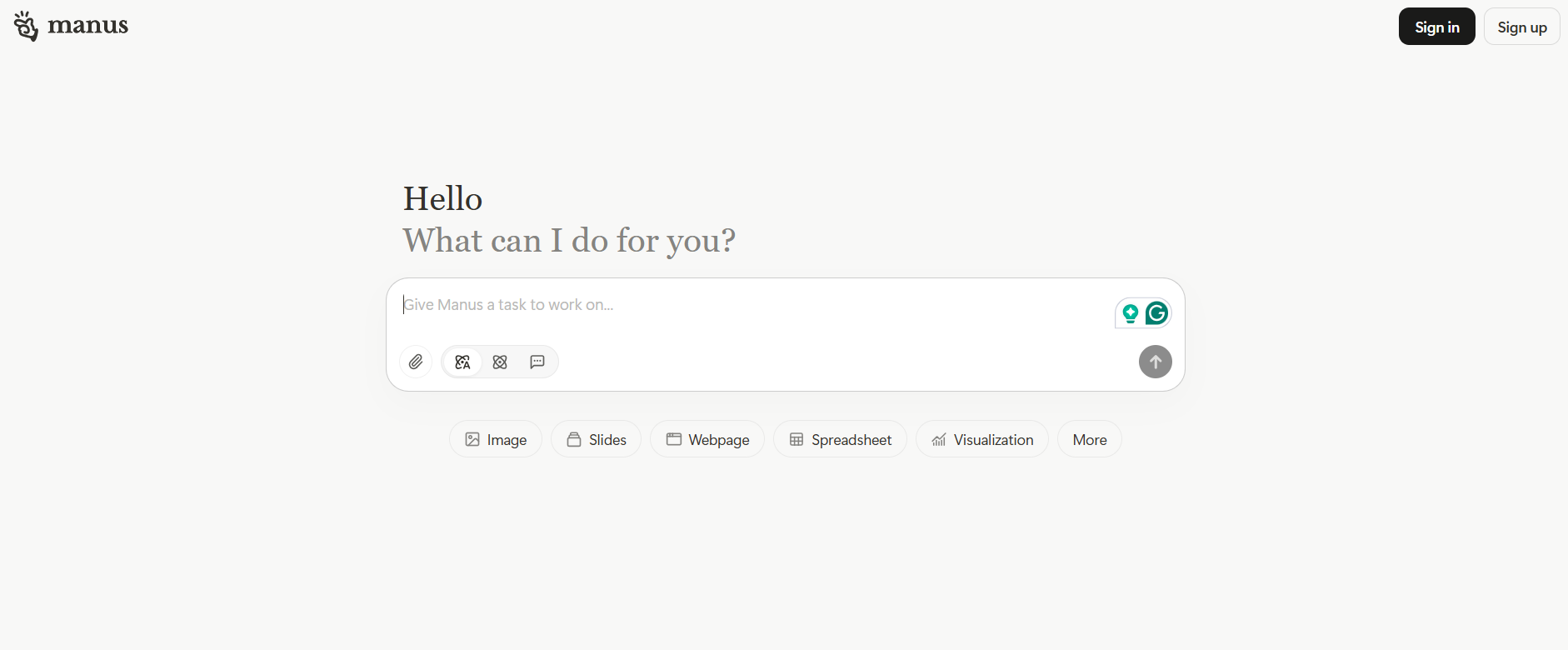
Manus AI positions itself as an AI agent that acts more like an AI teammate than a simple assistant. Instead of waiting for detailed instructions, Manus allows users to set a goal in natural language and then autonomously breaks it down into subtasks.
It can conduct data analysis, run code execution, generate reports, and even build visualizations using integrated tools.
Strengths
- Goal-based execution: users set objectives, and Manus completes them step by step
- Data processing and visualization for research, reporting, and analytics
- Workflow automations with scheduling and event triggers
- Code writing and deployment, including automation scripts and api calls
- Multi-agent coordination to tackle larger projects across various domains
Weaknesses
- Still new compared to other best AI agent platforms, with fewer established integrations
- Heavy usage may become costly since credit consumption scales with larger workloads
Manus AI Pricing
Manus AI offers a free plan with daily credits, while paid tiers start at $19/month and scale up to $199/month for higher usage.
13. Project Astra
Best for: Process vision, audio, and text together for real-world interaction
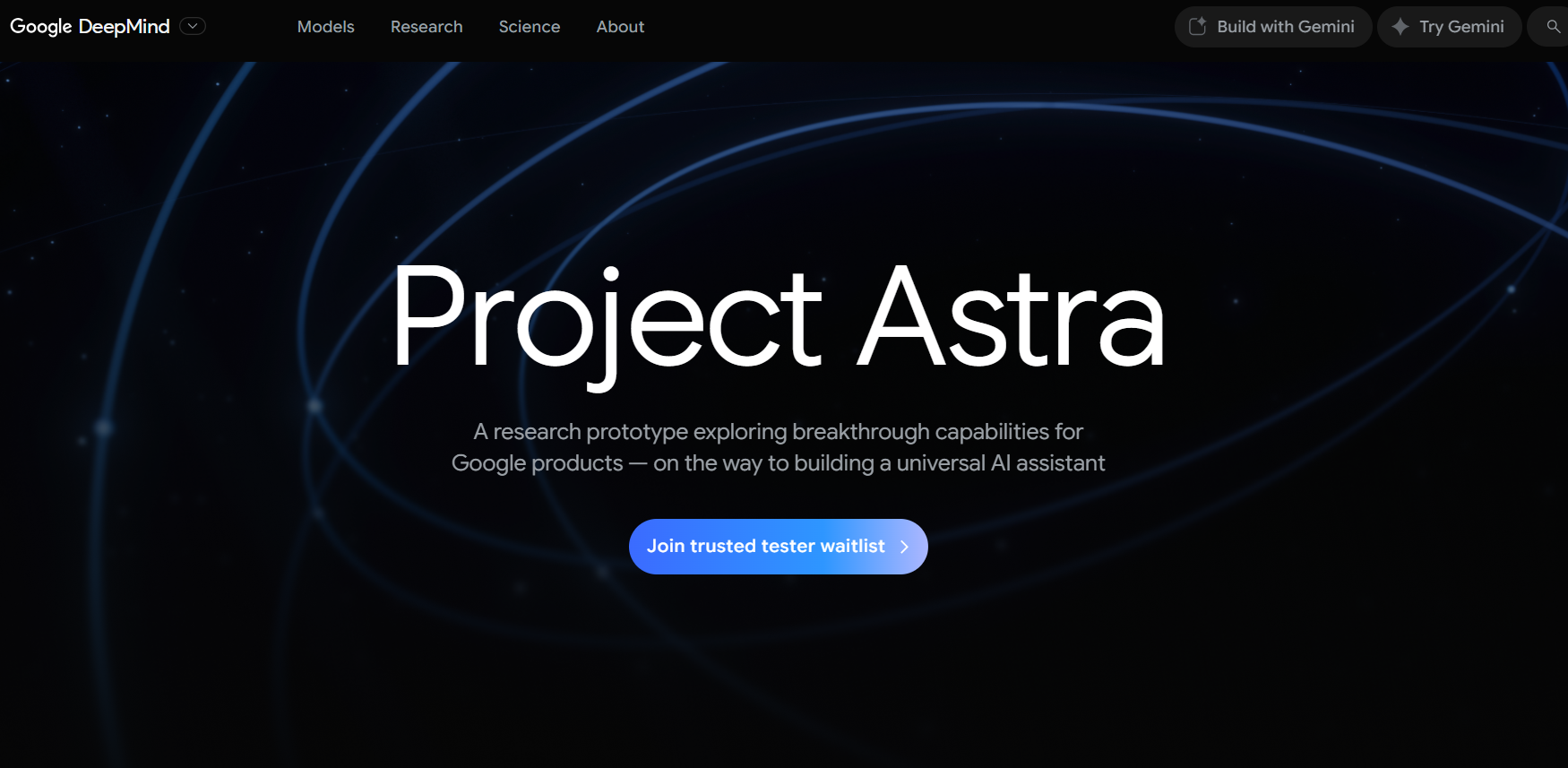
Project Astra is a research prototype from Google DeepMind aiming to build a universal AI agent with multimodal capabilities. It can process natural language, live video, images, and audio, use tools like Google Search, Lens, Maps, and maintain short-term memory (e.g., 10 minutes) to improve context awareness.
Some capabilities are already appearing in Gemini Live on Android, with screen sharing and visual understanding being rolled out. It’s designed for high adaptability, letting the agent perform tasks across various domains without requiring heavy prompt engineering.
Strengths
- Rsponds to what you see + what you say (camera, voice, image + video + text)
- Real-time tools & integrations:
- Retains short-term memory (about 10 minutes) and remembers past interactions & preferences to boost relevance in responses
- Natural language + visual interaction: describe what you see, ask questions about it, get actionable responses.
Weaknesses
- Still in prototype/research phase; not public for everyone yet, access limited to trusted testers and waitlist users
- Memory span is short (10 minutes per session), so long-term persistence / large-scale workflows might not yet be handled well.
Project Astra Pricing
No official pricing or public plan is available yet.
14. Vertex AI Agent Builder
Best for: Enterprises and teams that want to build custom AI agents at scale with strong cloud integrations and governance

Vertex AI Agent Builder is Google Cloud’s enterprise-focused platform for creating and managing AI agents. It combines no-code and low-code tools with the ability to plug into large language models from Google’s Gemini family and other LLM providers.
Designed for scalability, it allows businesses to create agents that can perform tasks across customer support, sales, operations, and workflow automations, while benefiting from Google Cloud’s security, monitoring, and compliance standards.
Strengths
- No-code and low-code agent builder with drag-and-drop design
- Integrates directly with Google Cloud services, APIs, and external tools
- Supports prompt engineering, memory, and multi-turn interactions
- Enterprise features: monitoring, observability, version control, and error handling
- Scales across teams with collaboration and role-based access
Weaknesses
- Heavily tied to the Google Cloud ecosystem, creating potential vendor lock-in
- Aimed at enterprise use cases, less suited for individuals or small startups compared to lighter AI apps
Vertex AI Pricing
Vertex AI Agent Builder follows Google Cloud’s usage-based pricing, with costs depending on model selection, API calls, and deployment scale.
15. Claude (Anthropic)
Best for: Reliable, safe, and high-performing AI agents for customer support, knowledge work, and automation

Claude, developed by Anthropic, is more than an advanced conversational AI assistant. It’s also widely used as the foundation for custom AI agents across various domains.
With its strong reasoning skills, extended context windows, and alignment focus, Claude enables developers and businesses to create autonomous agents that can handle complex tasks such as research, customer service, and document processing.
It integrates well with AI agent platforms like LangChain and CrewAI, making it a flexible option for building multi-agent systems.
Strengths
- Long context windows (up to 200K tokens) for deep data processing and answering questions over large documents
- Strong safety and alignment features, designed for trustworthy AI capabilities
- Compatible with major agent builder frameworks (LangChain, AutoGen, CrewAI)
- Effective at natural language processing, summarization, and reasoning across business processes
- Available through APIs, making integration with external tools straightforward
Weaknesses
- Requires developer setup or use of third-party agent platforms to function as a fully autonomous agent
Claude AI Pricing
Claude is available via API with usage-based pricing; cost depends on context window size, token volume, and deployment scale.
Best AI Agents in 2025: Quick Comparison


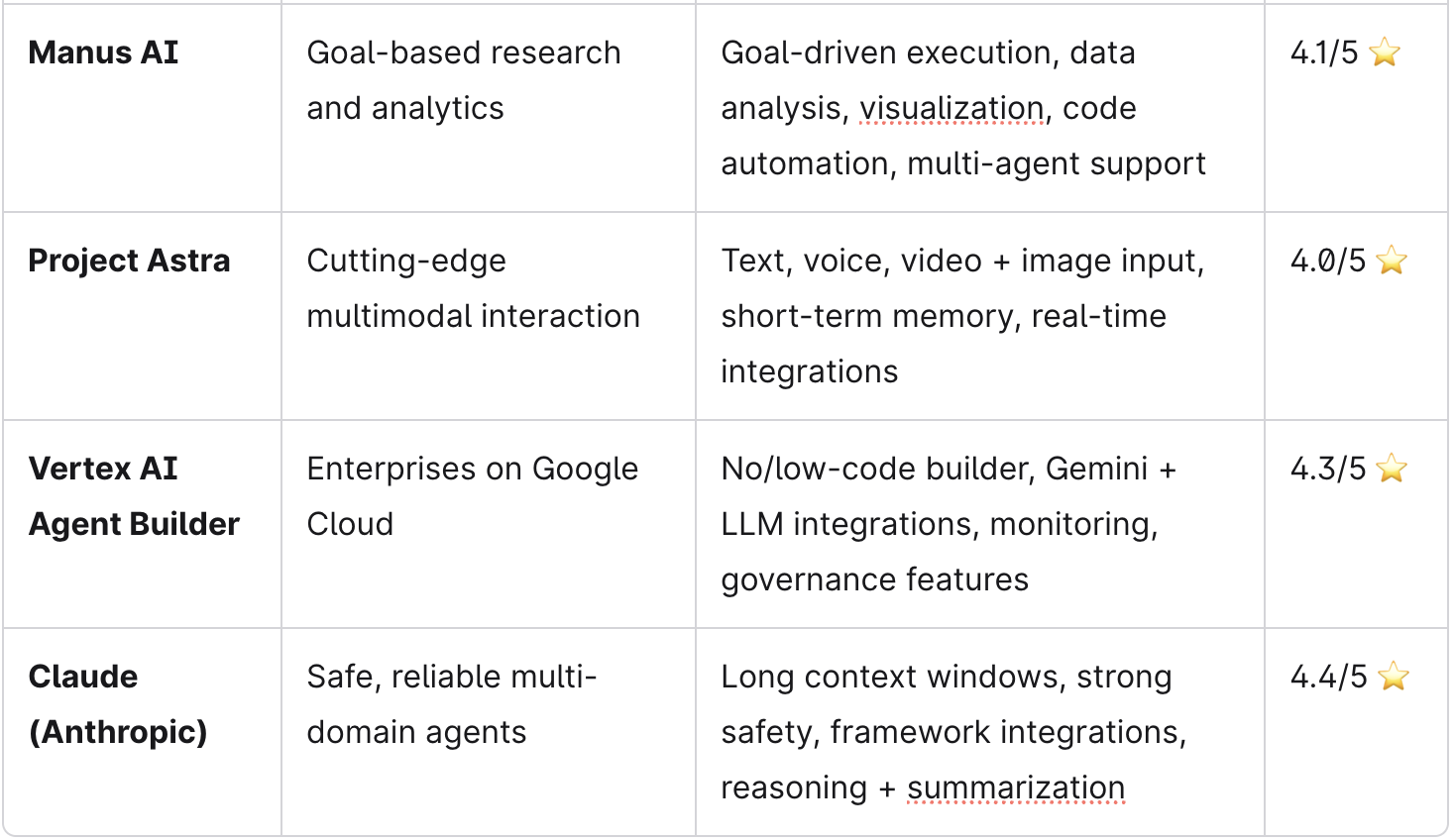
Which is the Best AI Agent in 2025?
The most popular options among developers are AutoGPT and LangChain, and they are powerful frameworks if you have the technical skills. But after testing different tools myself, I believe Sintra AI is the best overall choice.
It gives you a full set of role-based agents, not just one. With Brain AI keeping everything connected, it handles marketing, support, data, and other workflows without needing constant setup.
Many people make the mistake of picking tools that are either too technical to manage or too simple to grow with. Sintra AI avoids both problems by balancing ease of use with depth and scalability.

















